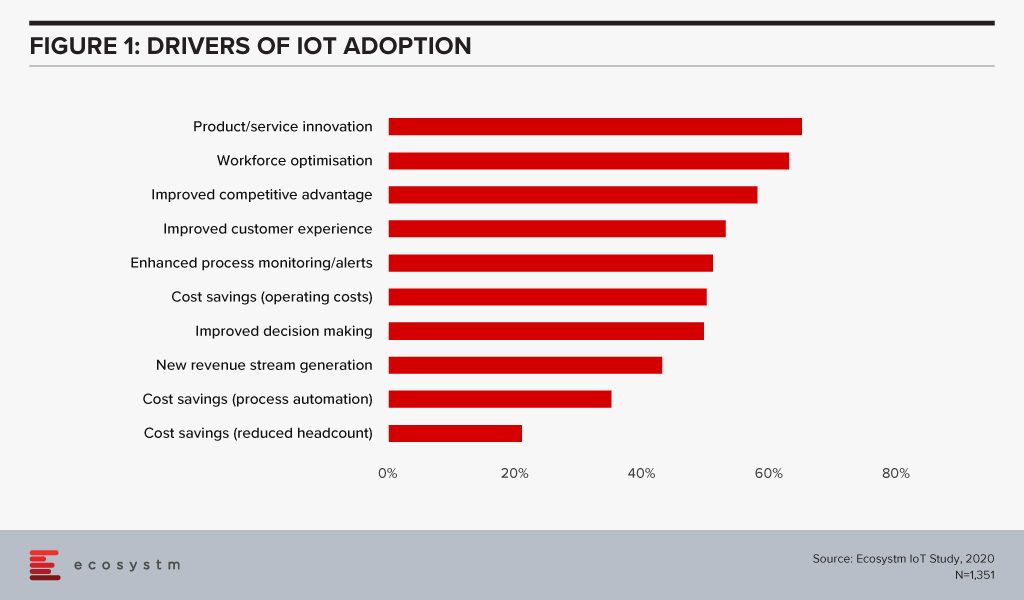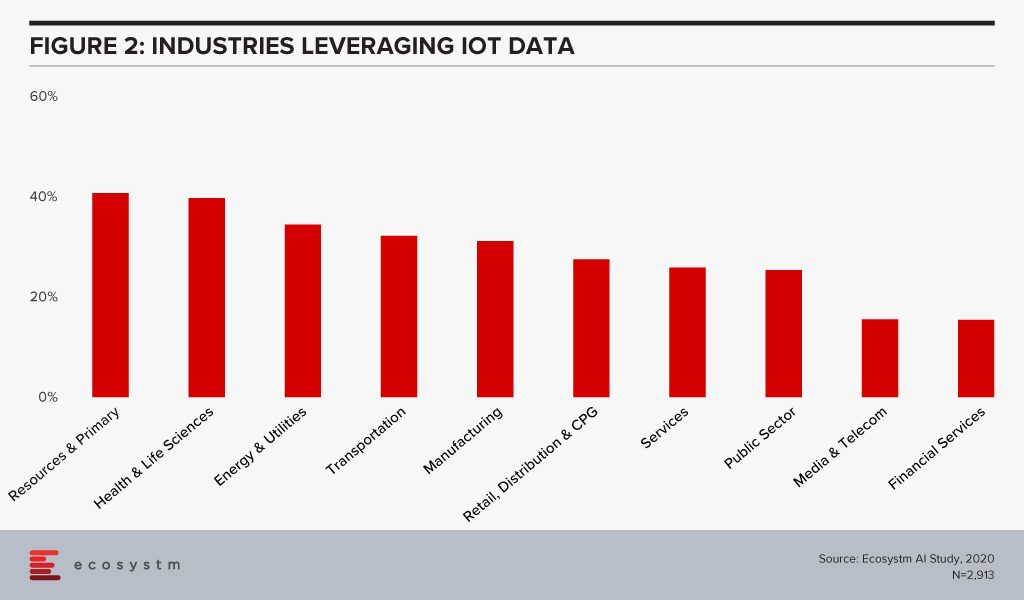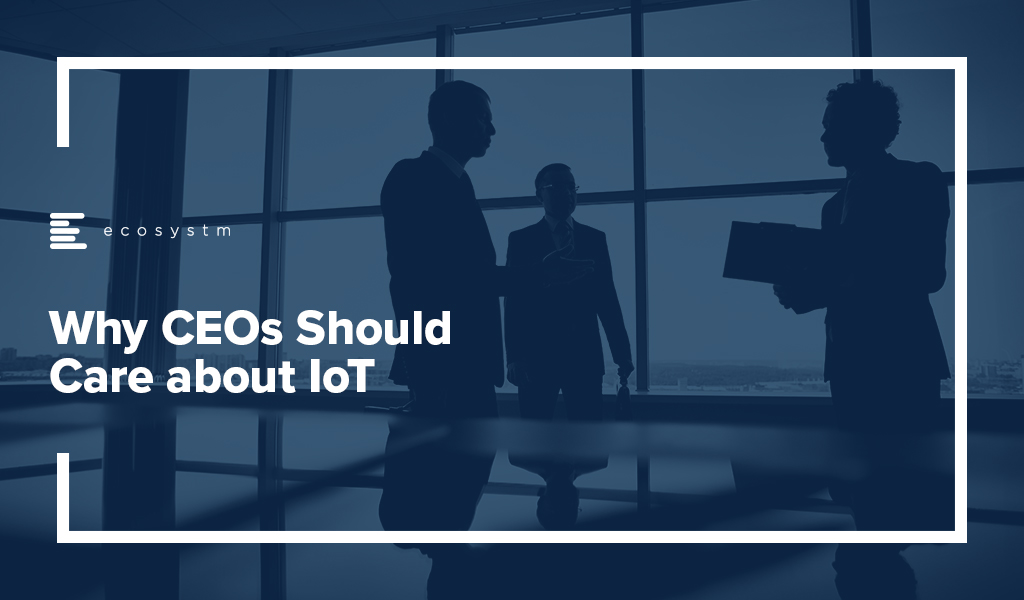Industry 4.0 has been driving technology adoption and innovation. Technologies such as the Internet of Things (IoT) are being evaluated by Operations and IT teams especially in manufacturing, primary industries and logistics. As we stand on the threshold of widespread 5G rollouts, the industry expects a larger uptake of IoT. However, organisations have found IoT implementations daunting for various reasons – concerns around security, technology integration challenges, customisation, system requirements and so on. The Global Ecosystm IoT Study finds that more than 70% of organisations implementing an IoT solution do not have an IoT strategy team. This has been the key barrier to successful IoT deployments. What is required is a separate IoT solutions team within organisations that reports to the CEO – either directly or through the COO or CFO.
Why should a CEO get involved in and have visibility into an organisation’s IoT projects? There are a few important reasons.
#1 IoT benefits go deeper than process automation
If we look at the top 5 drivers of IoT adoption, we realise immediately that organisations want to do more than automate processes through their IoT deployments (Figure 1). They want to innovate and are looking at IoT adoption to give them an edge over their competition – whether through cost optimisation or through improving the brand image. This cannot be done if organisations look at IoT as a one-off implementation to address one organisational issue – it often becomes a key component of their Digital Transformation (DX) journey.

This will require organisations to have conversations that go beyond process automation. The conversation should be about IoT as an enabler of broad corporate initiatives and should be tied back to an overall long-term strategy. The discussions cannot be asset-driven alone, focusing on enabling assets or devices to generate data with no long-term plan on how to use the data. The metrics have to shift to a ‘business outcomes’ group that includes data scientists, corporate marketing, and operations – with the direct involvement of the CEO. The outcomes can be innovative solutions, faster time to market, value-added services or competitive differentiation.
The high volume of real-time data generated by IoT devices can be analysed to develop customised services and solutions. IoT Analytics is driving decisions not just in inventory management and logistics – but in departments such as HR and marketing. Certainly, the CEO would want visibility of that intelligence and should be able to define the intelligence that will help him do his job better.
#2 In some industries at least, IoT will become mainstream
In some industries, IoT solutions have become mainstream – even if there has not been widespread adoption, the discussions about the impact of IoT certainly have (Figure 2). There are early adopters in these industries who have already seen a shift in organisational priorities and benefits derived.

It is the CEO’s job to track the developments and disrupters in their industries. It is the CEO’s job to decide whether the organisation will adopt IoT or not – but it has to be an informed decision. It has to take into consideration the organisation’s culture and capabilities – again that falls under the purview of the CEO.
CEOs in primary industries have to be aware that there are organisations in the industry that are leveraging AI-enabled IoT for cost savings through process automation and for greater visibility of the entire supply chain. Not only are these companies benefitting financially but are also being able to increase the traceability of their products. In agriculture ‘farm-to-fork’ has become a best practice that has the potential to disrupt the industry. Similarly, healthcare CEOs must know that IoT empowers the clinicians immensely, through asset performance management, workforce optimisation and also through the ability to deliver better health outcomes. Again the role of IoT in value-based healthcare is something that CEOs should familiarise themselves with.
#3 Technology disruption will continue to be part of the conversation
No CEO can only focus on business and leave technology to the CIO in today’s disruptive world. There are many technologies that will be part of the larger conversation – and many of these will work in sync with the IoT systems. IoT implementations do not end with installing sensors. While devices, protocols and networks will be handled by CIOs, there are areas where CEOs will have to be consulted, for example, adoption of 5G. Smart Manufacturing and Industry 4.0 initiatives will look to use 5G to gain real-time information to address demand, supply and customer requirements. However, telecom operators are also expected to evolve their existing business models when engaging with enterprises. Changes such as this will require the attention of the CEO.
Another area that will require the CEO’s attention is cybersecurity – millions of devices producing massive data are not only difficult to manage but would also be prone to hacking, network security issues, security breaches and attacks. IoT and other technologies, and the cyber risks associated require the Board and the CEO to evaluate the organisation’s risk exposure including financial remediation. Many organisations have a dedicated responsibility for their cybersecurity practice – the Chief Information Security Officer (CISO) is the key data protection lead and reports directly to the CEO and not to the CIO to avoid a conflict of interest.
As has been mentioned earlier, organisations looking to derive intelligence from their IoT data will need the CEO to play an active role in deciding the nature of the intelligence that is likely to benefit the organisation best. Another area that CEOs will need to have oversight on is the wide range of social, ethical and legal issues that could arise due to the sheer volume of the data collected and the organisation’s data handling practices. Governments across the globe have implemented strict data security and privacy compliance laws. CEOs should be aware of the implications of the data they collect, store, process and use.
#4 IoT projects are not always successful
Implementing and harnessing the true potential of IoT is a big challenge from a CEO’s perspective. Investing in technology and not deriving any benefits could be disastrous for a company in terms of time, effort and cost. CEOs should understand the technology, its integration with the processes and ways to optimise the implementation.
Once the organisation has evaluated the need for an IoT system, it should look at the common reasons why IoT projects fail in other organisations. One of the main reasons is that 98% of organisations have IT teams lead their IoT projects. When you compare this to the 38% of organisations that involve Operations – and that is the function that benefits most from IoT implementations currently – it becomes apparent that key stakeholders are not often involved.
The biggest challenge that IoT implementations face is change management and user adoption. This often gets overshadowed by predominant concerns on technology and cost challenges. The involvement of the CEO and the business functions at an early stage of any IoT deployment helps mitigate that challenge. It would help in not only identifying the right use cases and a better business case but also in higher user adoption because of their involvement (and buy-in) from an early stage. This organisation-wide mandate has to be led by the CEO.
No longer can the CEO focus merely on the business and leave technology to the office of the CIO. Today’s CEO has to be aware of the benefits of technology, the implications for the organisations and the challenges associated with the implementation.



